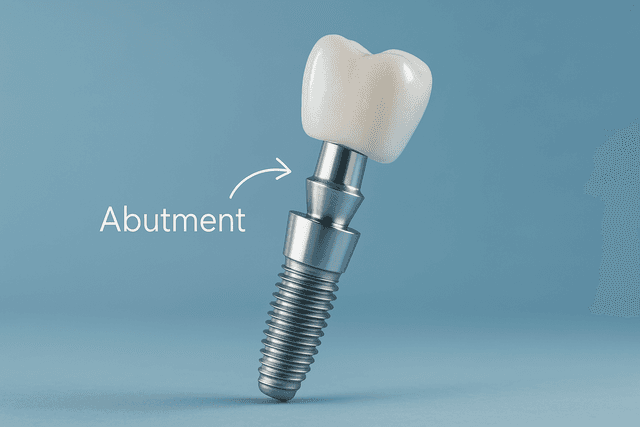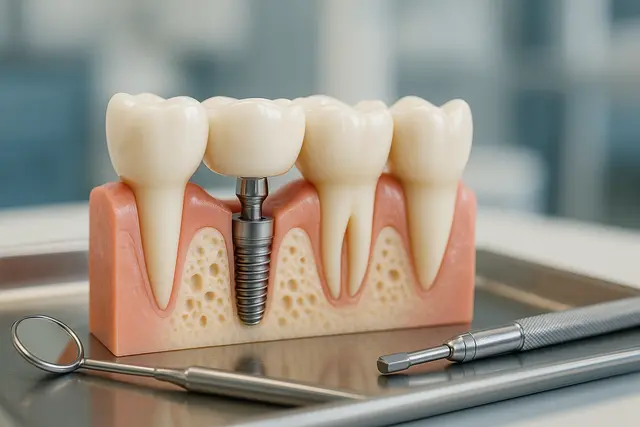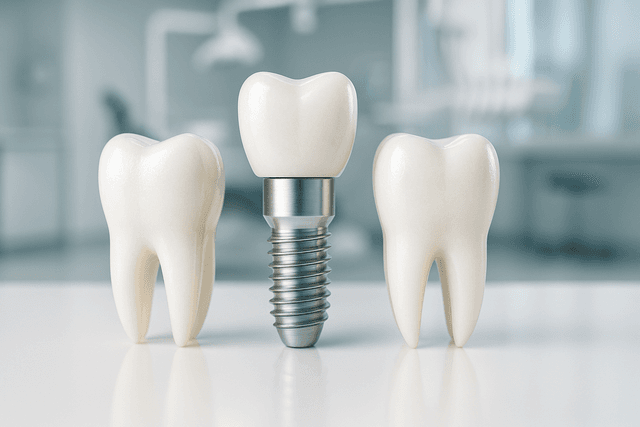Prosthodontics
5 min read
Oct 05, 2025
Implant Failure After Years: Why It Happens
Getting a dental implant feels like the final chapter in a long dental journey, problem solved, smile restored. But what if that trusty implant starts acting up years later? While it's rare, long-term implant failure does happen, and it can catch people completely off guard.

You did it. You got the dental implant. The procedure went well, you followed all the instructions, and for years everything felt perfect. Until… something doesn’t feel quite right. A little tenderness. A strange wiggle. Maybe even pain. You’re thinking, “Wait, can a dental implant fail after all this time?”
Unfortunately, yes. Implant failure can happen, even years after placement. It’s rare, but when it does strike, it can be frustrating, painful, and costly.
Dental Implant Basics You Should Know
A dental implant is a small titanium post (or sometimes zirconia) that acts like the root of a tooth. It’s placed into your jawbone during implant surgery, and over time, it fuses with your bone in a process called implant osseointegration. Once healed, a crown is placed on top, completing the restoration.
Dental implants are the gold standard in tooth replacement, and the success rate is impressively high. Still, implants can fail. In fact, dental implant failure is classified into two buckets: early and late. Early implant failure shows up within the first few months after implant placement, while late implant failure may occur years after placement, even long after the tooth feels fine.
Implant Failure Can Happen Even Years Later
Let’s talk about that dreaded word: failure. Implant failure isn’t always dramatic. Sometimes, it sneaks in quietly. Other times, it’s like a slap in the mouth, literally.
Late implant failure, which can occur years after placement, often stems from different causes than early failure. You might have had flawless healing and great implant stability at first, only for something to shift over time. You’re not alone. Many patients experience implant failure years down the road.
Common Causes of Late Implant Failure
So, why do dental implants fail after they’ve been sitting pretty for years? Here are some of the most common causes of late implant failure:
Peri-Implantitis: Think of this as gum disease for implants. It’s an infection around dental implants that can lead to bone loss. Poor oral hygiene is the biggest risk factor for implant. Without good brushing, flossing, and regular dental check-ups, bacteria can sneak in and cause damage around the implant.
Bite Forces and Grinding: If you grind your teeth at night (hello, stress), the pressure can slowly wear down the implant. A night guard can help protect your investment. Without it, you might end up with a loose dental implant years after placement.
Bone Loss Over Time: Bone loss is sneaky. It doesn’t always cause pain, but it can affect the stability of the implant. When the bone around the implant shrinks, it compromises support, possibly leading to implant loss.
Smoking and Medical Conditions: Smoking, uncontrolled diabetes, and other chronic health issues can increase the risk of implant failure. They reduce blood flow, slow healing, and lead to inflammation around the implant site.
Retained Subgingival Dental Cement: Yep, sometimes leftover dental cement from the crown placement causes inflammation. It’s rare, but this tiny mistake can lead to implant failure years after placement.
Signs of Dental Implant Problems You Shouldn’t Ignore
How do you know something’s off? Here are red flags that might mean you're dealing with a failed implant:
Swelling or tenderness around the area
Bleeding or pus when brushing
A bad taste in your mouth that doesn’t go away
Discomfort when biting or chewing
If these sound familiar, it’s time to see your dentist, stat.
Why Dental Implants Fail After Years
Late failure happens when things change over time. Bone density can decrease. Your bite can shift. You may skip a few dental check-ups (life happens, right?). All of these factors can lead to implant failure.
The placement of the implant matters too. Implants placed in areas with low bone volume or density may be more likely to fail due to lack of support. And if the implant surface wasn’t ideal or healing didn’t go perfectly, it may have set the stage for future problems.
Implants Can Fail but That Doesn’t Mean It’s Over
The good news? A failed dental implant isn’t the end of the road. If the problem is caught early, treatment options like deep cleanings, bone grafts, or even antibiotics may help. In more serious cases, your implant dentist may need to remove the implant and allow the area to heal.
Sometimes, after healing, a new implant can be placed. The key is working with a skilled, experienced implant dentist who understands how to restore implant health.
Prevent Dental Implant Failure Before It Starts
No one wants to go through implant treatment twice. Here’s how to avoid it:
Practice great oral hygiene every day
Schedule regular dental visits to monitor implant health
Use a night guard if you clench or grind your teeth
Avoid smoking and manage health conditions
Be mindful of changes in how your bite feels
Don’t ignore discomfort around the implant
Even years later, your dental care routine plays a huge role in keeping your implant stable.
Dental Implant May Feel Fine Until It Doesn’t
That’s the thing about late failure. It can creep in slowly. Many patients with a failed implant say everything felt fine until one day, it didn’t. That’s why monitoring is so important. Just because the implant can last decades doesn’t mean it will if you ignore it.
Implants need attention. They’re strong, but they’re not invincible. Proper dental treatment and a trusted dental professional make all the difference.
Book a Dental Implant Check-Up Before Trouble Starts
Here’s your friendly reminder: don’t wait for signs of trouble. If it’s been a while since you’ve had your implants evaluated, or if you’re unsure about something you’re feeling around your tooth or implant site, book a dental implant check-up.
An implant dentist can check for early signs of bone loss, peri-implantitis, or implant mobility. Catching problems early could save the implant, and save you from the hassle of more surgery.
Can a Dental Implant Fail Years After Placement?
Yes, dental implant failure can occur even years after successful placement. This is known as late implant failure and may result from gradual bone loss, infection (like peri-implantitis), poor oral hygiene, or medical conditions that affect healing. Even if your implant has been stable for a long time, changes in your bite, bone density, or overall health can compromise its success over time.
What Are the Most Common Causes of Late Implant Failure?
Late failure is often caused by peri-implantitis (a gum infection around the implant), excessive bite forces or grinding, gradual bone loss, smoking, and chronic health conditions like uncontrolled diabetes. In some cases, leftover dental cement from the crown placement can also trigger inflammation and implant instability. Without regular check-ups, these issues may go unnoticed until failure occurs.
What Are Warning Signs of a Failing Dental Implant?
Common signs include implant mobility, pain or discomfort when chewing, swelling or bleeding near the site, pus discharge, or a persistent bad taste in your mouth. These symptoms may seem minor at first but can indicate serious underlying problems. If you notice any of these, it’s essential to contact your implant dentist immediately to prevent further damage.
How Can You Prevent Long-Term Implant Failure?
Preventing implant failure involves daily brushing and flossing, regular dental visits, wearing a night guard if you grind your teeth, and managing conditions like diabetes. Avoid smoking and be proactive about any changes in how your implant feels. Early detection of problems through dental check-ups significantly increases the chance of saving the implant before it fails completely.
Read Next
Related Posts

Prosthodontics
Implant Abutment Explained: What It Is and Why It Matters
Dental implants have revolutionized the way we restore missing teeth, but there's more to them than just the visible crown. One often-overlooked component, the implant abutment, plays a crucial role in both the function and appearance of the final result. Understanding what it is and why it matters can make all the difference in your implant journey.
4 min read
Oct 10, 2025

Prosthodontics
Pros and Cons of Implant Retained Bridges: A Simple, Honest Overview
Missing teeth can affect more than just your smile, they can impact your confidence, speech, and even how you eat. With so many options out there, it’s easy to feel lost in dental jargon and marketing buzzwords. That’s why we’re breaking down implant retained bridges in plain English, highlighting the pros and cons so you can make an informed choice without the fluff.
6 min read
Oct 10, 2025

Prosthodontics
Implant Crown Lifespan: What to Expect
Getting a dental implant crown is a big step toward restoring both function and confidence in your smile. But like any dental work, it's natural to wonder how long it will actually hold up. From materials and maintenance to daily habits, several factors play a role in how long your implant crown will last.
4 min read
Oct 10, 2025
Don’t have time to research every dentist around you?
See why 30k+ patients trusted us